May 12, 2025 – 85th Day of the 100-Day Dharma Talk, Heart Sutra Lecture 5, Buddhist Social Studies Course Lecture 18
Hello. Today is the 85th day of Venerable Pomnyun Sunim’s 100-Day Dharma Talk. Today, there will be a sutra lecture and a Buddhist Social Studies Course lecture.
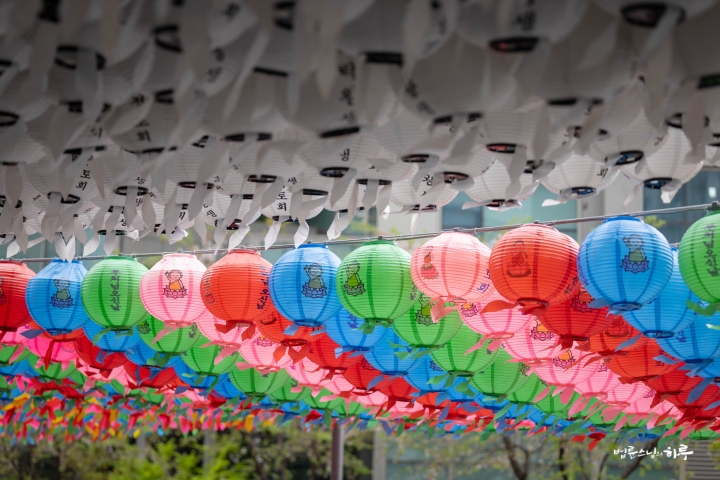
After completing his morning practice and meditation, Sunim headed to the Jungto Social and Cultural Center to give the sutra lecture.

About 100 people gathered in the third-floor Dharma hall, while approximately 560 people connected online for the live broadcast. After the audience requested the Dharma talk with three full bows, Sunim ascended to the Dharma seat.
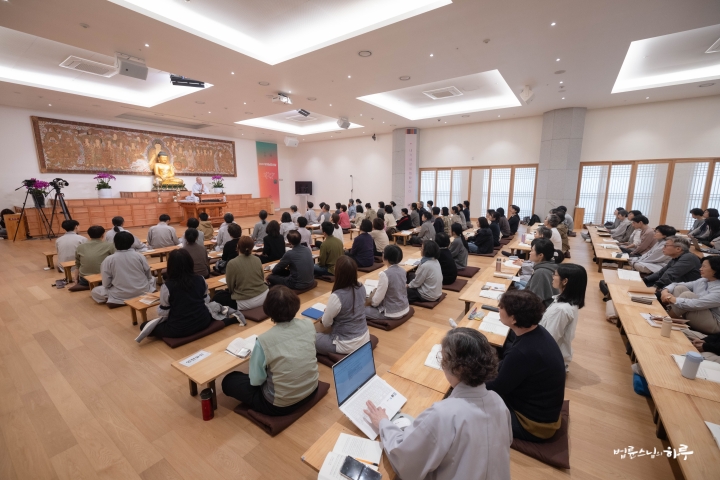
Sunim briefly summarized the content covered in previous sessions before continuing with the fifth lecture on the Heart Sutra.
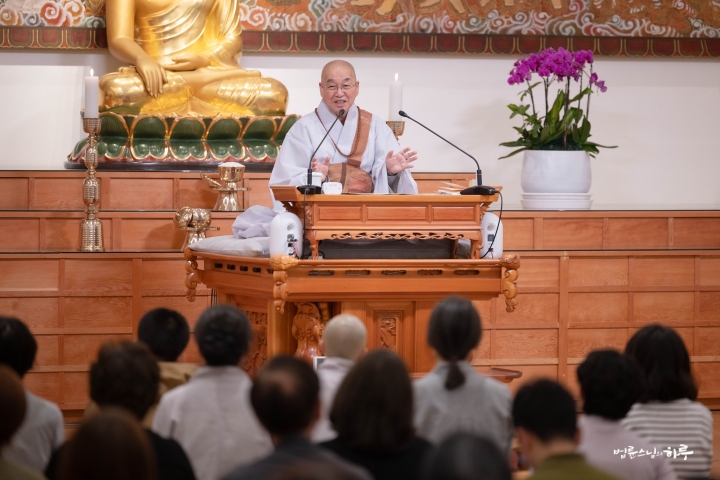
“The Heart Sutra primarily criticizes Hinayana doctrines from a Mahayana perspective. The core argument is that Hinayana practitioners cling to the Buddha’s teachings and establish dharma characteristics (法相). The Heart Sutra develops a logic that breaks down these characteristics and destroys attachment to them.
The Five Aggregates, Twelve Sense Bases, and Eighteen Elements Have No Inherent Existence
Understanding the historical context in which the Heart Sutra was expounded helps us understand the Hinayana doctrines that were prevalent at that time. The core of Hinayana teachings during that period consisted of the Five Aggregates (五蘊), Twelve Sense Bases (十二處), Eighteen Elements (十八界), Twelve Links of Dependent Origination (十二緣起), and Four Noble Truths (四聖諦). The following passage critiques misunderstandings of these doctrines one by one.
Therefore, in emptiness there is no form, no feeling, no perception, no mental formation, no consciousness; no eye, ear, nose, tongue, body, or mind; no form, sound, smell, taste, touch, or dharmas; no realm of the eye, up to no realm of mind-consciousness; no ignorance and also no extinction of ignorance; up to no aging and death and also no extinction of aging and death; no suffering, no origin of suffering, no cessation of suffering, no path; no wisdom and also no attainment.
The Five Aggregates (五蘊) refer to form, feeling, perception, mental formation, and consciousness (色受想行識). ‘Form’ (色) refers to what we see, hear, smell, taste, touch, and know through thinking. ‘Feeling’ (受) is what we experience, and ‘perception’ (想) is the function of memory and thought. ‘Mental formation’ (行) is the function that generates desire and activates will, while ‘consciousness’ (識) is the foundation of awareness that operates anytime and anywhere as these actions accumulate. The ‘Five Aggregates theory’ views what we perceive as ‘self’ as being composed of these five functions.
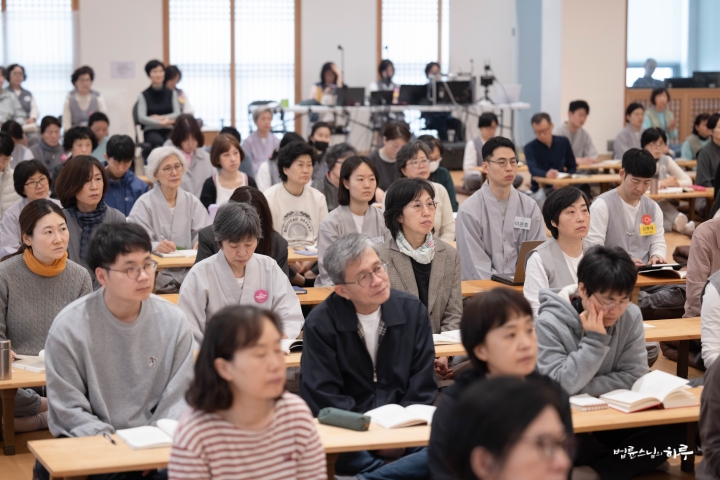
For example, when we see an object, we don’t simply recognize it; we also experience pleasant or unpleasant feelings, and even desires may arise. This is why expressions like ‘the eye is burning’ or ‘the ear is burning’ appear in the sutras—because desire arises in the process of seeing and hearing. The Five Aggregates explain the comprehensive process of how desire, feeling, and thought work together. They provide a concrete and logical explanation of how the mind functions. All our judgments about what is ‘right,’ ‘wrong,’ ‘correct,’ ‘incorrect,’ ‘big,’ or ‘small’ ultimately stem from these five functions. The core of the Buddha’s teaching is that there is no need to cling to these constantly arising functions. However, people are dictated by tastes and smells. Being controlled by smells leads to buying expensive perfumes, and being controlled by taste leads to seeking out meals that cost hundreds of thousands of won. Being dictated by the eye creates the desire to purchase necklaces and rings worth tens of millions of won, and being dictated by sound generates the desire to buy speakers worth tens of millions of won.
Early practitioners, however, let go of attachment to the body and were not controlled by sensory boundaries—landscapes, sounds, smells, tastes, touches, and all kinds of thoughts. This allowed them to reach peaceful nirvana. While direct experience was important, gradually, as academic approaches to studying and explaining doctrines increased, all of this became conceptualized. Instead of experiencing concepts like the Five Aggregates, Twelve Sense Bases, and Eighteen Elements, people began to understand them through explanations, leading them to regard these concepts as actual existing elements. For instance, the five functions of the aggregates or the items in the Twelve Sense Bases and Eighteen Elements came to be accepted as fixed entities or frameworks. As a result, people became busy memorizing and learning doctrines, debating and interpreting them.
However, from the perspective that all dharmas are empty (空), there is no such thing as form (色). This doesn’t mean we don’t know anything. It means that knowing doesn’t operate through some fixed entity but arises differently according to situations and conditions. The same applies to feelings and thoughts. They change from moment to moment, and the mind constantly shifts. To deny the Five Aggregates doesn’t mean the doctrine is wrong. It means rejecting the attitude of clinging to the Five Aggregates as fixed entities and treating the five functions as independent elements. This is what the Heart Sutra expresses as ‘there is no form, no feeling, perception, mental formation, or consciousness.’
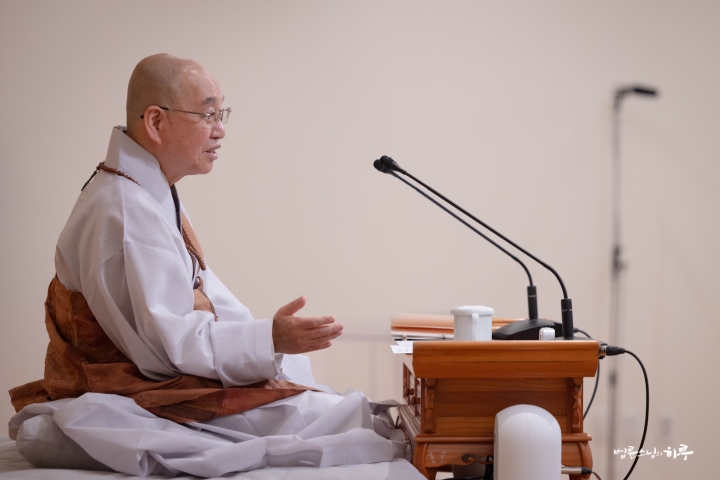
Similarly, in the next passage, it negates the element theory of the twelve sense bases (十二處) and criticizes the element theory of the eighteen realms (十八界). Following this comes the content that negates the element theory of the twelve links of dependent origination.
Even the Twelve Links of Dependent Origination Have No Fixed Essence
For example, let’s say you’re suffering because you lost a gold nugget. Why are you suffering? Throughout our lives, we lose countless things and sometimes have to let go of things we want. Among all possessions, people value their bodies the most. Yet even this body is not permanent. The cells that make up our bodies completely change every six months. As we eat, sleep, and wake up each day, at some point the old cells leave and new cells form. No matter how precious our bodies are, there’s no need to collect and preserve the old cells forever.
So many things pass through our lives. Nevertheless, if we suffer because we’ve lost something, it’s because we’re attached to that object. Why did we become attached to the gold nugget? Because we thought it was gold. What if we scratched the gold nugget with a knife and discovered it was merely gold-plated? At that moment, the attachment would break. The thought “It’s gold!” is precisely the thought that there is a fixed essence. Realizing “It’s fake!” corresponds to understanding that there is no fixed essence. To borrow an expression from the Diamond Sutra, we have created a “mark” (相). Thoughts like “It’s valuable gold” or “It’s real gold!” are creating marks by believing something has a fixed essence. When we trace the fundamental cause of suffering, the connected process reveals itself step by step. This process explained in twelve links is precisely the Twelve Links of Dependent Origination (十二緣起).
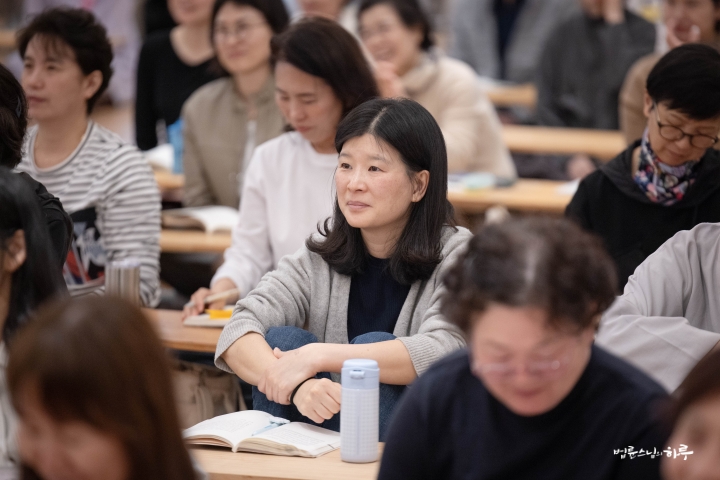
The first link in the Twelve Links of Dependent Origination is ignorance (無明). The phrase “there is no ignorance, nor is there an end to ignorance” means that ignorance has no inherent existence. According to the chain of causation, ignorance gives rise to formations (行), formations give rise to consciousness (識), and so on, leading to birth, aging, sickness, death, and all forms of suffering. However, when we penetrate to the essential level, ignorance is not some predetermined entity. It is merely a momentary arising of deluded thought. It is simply the functioning of a deluded mind, not a fixed entity called “ignorance” that has always existed. Therefore, “no ignorance” means there is nothing that can be called ignorance, and “no end of ignorance” means that eliminating ignorance is not possible. In other words, since ignorance does not inherently exist, there is nothing to eliminate.
The last link in the Twelve Links of Dependent Origination is “aging and death” (老死). The phrase “no aging and death, and also no end to aging and death” means exactly that—there is no aging and death, nor is there an end to aging and death. In this way, the Heart Sutra negates everything from the first link of the Twelve Links, ignorance, all the way to the final link, aging and death.
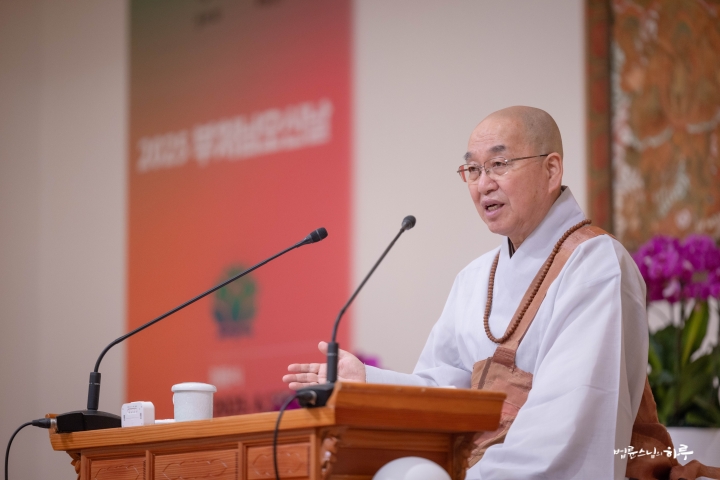
In Theravada Buddhism, there are primarily Sravakas and Pratyekabuddhas. Sravakas follow a practice that leads to enlightenment by studying the Four Noble Truths, the Eightfold Path, the Five Aggregates, the Twelve Sense Bases, and the Eighteen Elements. Pratyekabuddhas follow a practice that leads to enlightenment by contemplating the Twelve Links of Dependent Origination. Therefore, denying all of these means rejecting all the conceptualized doctrines of Theravada Buddhism.
Originally, There Is No Suffering and Nothing to Eliminate
Typically, when we experience suffering, we try to eliminate it. We believe that suffering exists and that there is a way to remove it. We think, “I was suffering at first, but through some method of practice, the suffering disappeared, so I eliminated the suffering that existed.” However, the Mahayana perspective differs. When we feel “I am suffering,” if we keep asking why we’re suffering, we eventually realize that suffering has no inherent existence. For example, if you feel pain after breaking up with a partner, keep asking yourself, “Why am I suffering?” Eventually, you’ll realize, “Yes, we broke up, but that’s not inherently a cause for suffering.” The Mahayana perspective is not about eliminating existing suffering but realizing that suffering never truly existed in the first place. “No suffering, no origin, no cessation, no path” means there is no suffering, no cause of suffering, no cessation of suffering, and no path to the cessation of suffering.
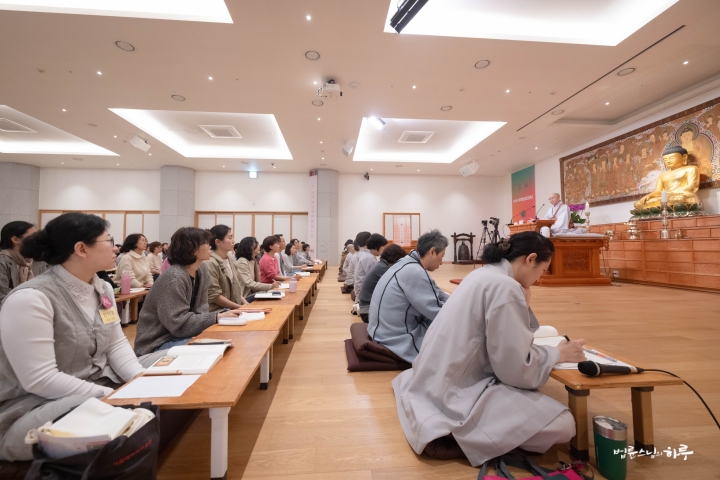
In a dream, being chased by a robber feels frightening and painful. At that moment, the suffering certainly exists. However, upon waking, you realize there was no robber and nothing to fear. For instance, imagine in your dream you’re being chased by a robber when Avalokitesvara Bodhisattva appears and rescues you. You manage to escape safely and express your gratitude, but when you open your eyes, you realize it was all a dream. There was no robber, no Avalokitesvara Bodhisattva, and both the suffering and gratitude were illusions. Is there any need to find the cause of suffering then? That’s why the expression “in emptiness” at the beginning can be understood as “when you open your eyes and see.” It means the world we live in is like dreaming with our eyes closed.
In a dream, there is suffering, the cause of suffering, the path to eliminate suffering, and the state where suffering has disappeared. But the moment you open your eyes and realize “It was just a dream!” it’s over. Yet, we often try to analyze why we had such a dream even after waking up, as if the dream were reality. A practitioner doesn’t do this. Upon opening their eyes, they simply think, “Oh! It was a dream!” and that’s it. If they add anything, it might be, “I almost fell for it.” This means they momentarily mistook something false for something real, but now they know better.
There Is No Enlightenment and No Attainment of Enlightenment
When you realize that suffering doesn’t inherently exist, the cause of suffering, the process of eliminating suffering, and the path to eliminate suffering all become meaningless. Taking a step further, even the realization of the Four Noble Truths isn’t something with any inherent substance. Since there is no such thing as enlightenment, there is nothing to attain. That’s why it’s expressed as “no wisdom and no attainment,” meaning there is neither enlightenment nor the attainment of enlightenment.
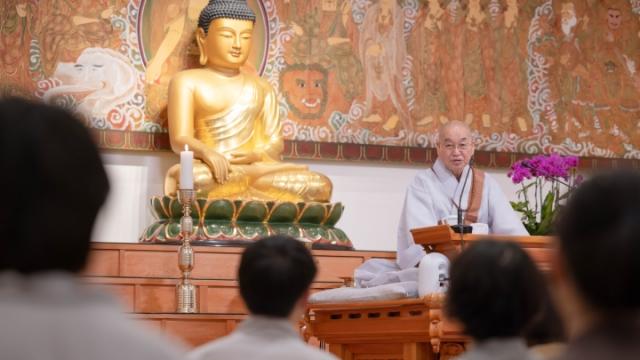
The expression “no place to abide, no attainment” refutes the Arhat state described in Hinayana Buddhism. In Hinayana, practitioners often say, “I have attained enlightenment” or “I have reached the state of an Arhat.” But if one has truly attained enlightenment, would one’s head be bowed in humility or would one’s neck be stiff with pride? What is the premise for claiming enlightenment? It comes from believing that enlightenment is some kind of entity that one can possess, and thinking that one has obtained it. The core teaching of the Heart Sutra is to negate all such substantiality.
In this way, the Heart Sutra points out the misunderstandings of the Dharma in Hinayana Buddhism. Between the 1st century BCE and the 2nd century CE, Hinayana Buddhism had become excessively academic and tended to rely on authority and conceptualization. The Heart Sutra criticizes these misguided directions of Hinayana Buddhism. However, we should not interpret this to mean “Mahayana is superior.” We should understand that it is not criticizing Hinayana doctrine itself, but rather criticizing the misunderstanding of the Buddha’s teachings.”
Thanks to Sunim’s various examples, the participants in the sutra lecture were able to gain a deeper understanding of the concept of emptiness (śūnyatā) in Mahayana Buddhism.
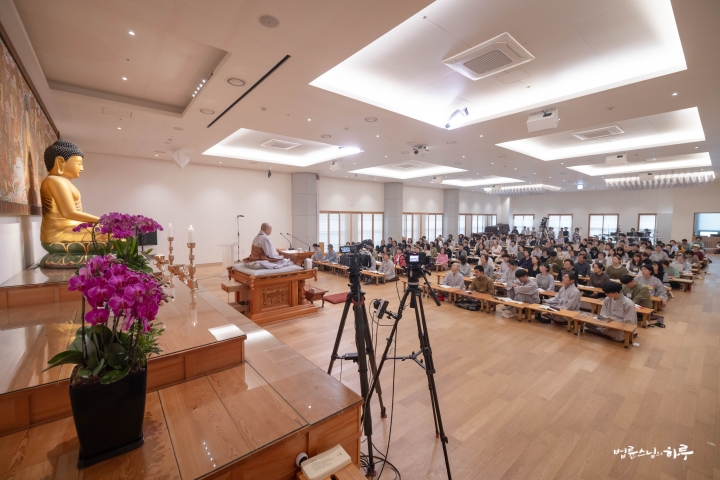
Participants gathered in groups for mindful sharing, while Sunim moved to the basement dining hall to have lunch with the Sangha. In the afternoon, he attended to administrative work in the office and prepared for the evening Buddhist Social Studies Course lecture.
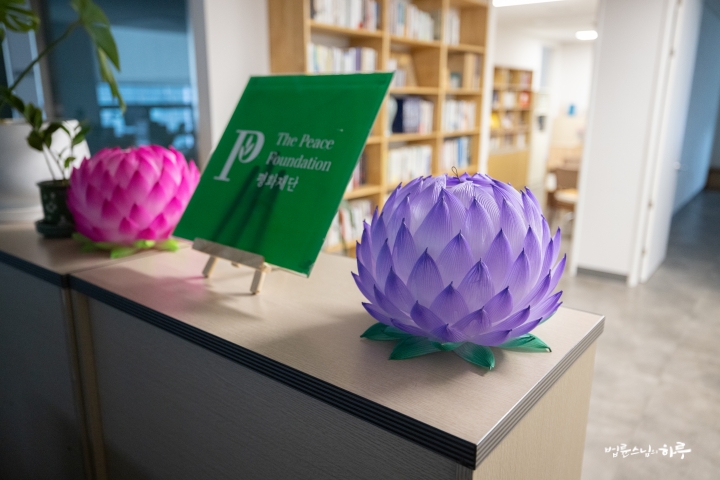
Sunim took a moment to share mugwort rice cakes with the staff, made from mugwort he had personally harvested and prepared at Dubuk Retreat Center the day before.
“Here, have some mugwort rice cakes while you work.”
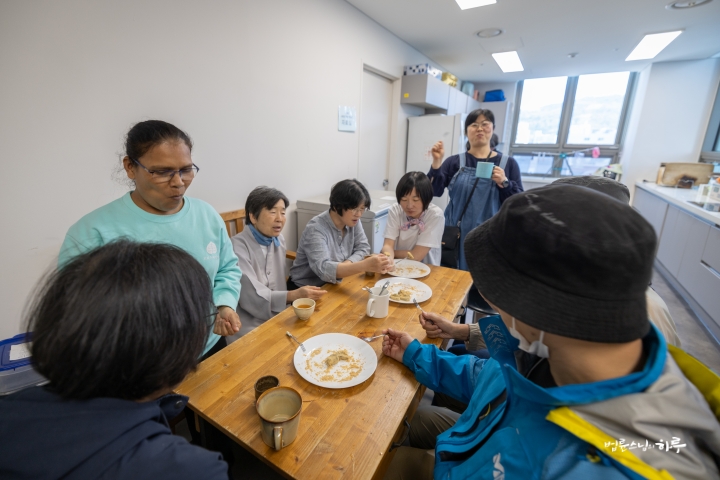

The staff each tasted a piece of the rice cake before returning to their work.
As the sun set, at 6:30 PM, Yang Chang-shik, Global Chair of the Universal Peace Federation (UPF), and Kim Jung-nam visited Sunim for a meeting. Sunim discussed how the risk of war on the Korean Peninsula had decreased due to Trump’s re-election and the president’s impeachment. They exchanged views on how to normalize North Korea-US relations and transform inter-Korean relations into reconciliation and cooperation.
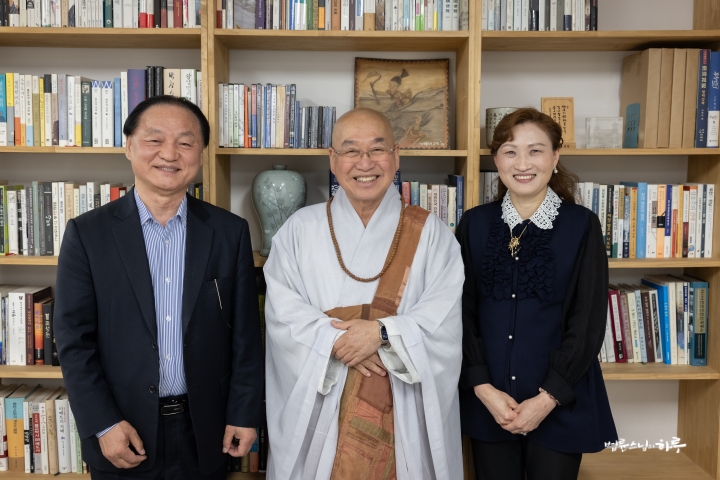
After seeing off his guests, at 7:30 PM, Sunim delivered the 18th lecture of the Buddhist Social Studies Course in the basement auditorium of the Jungto Social and Cultural Center. About 170 people attended in person, while approximately 1,900 connected online.

In the previous session, they had learned about the Buddhist perspective on solving environmental pollution problems under the theme “Climate Crisis and Stopping Consumption.” Today, Sunim continued with a lecture on Buddhist peace philosophy under the theme “Can We Change the World Through Peaceful Methods?”
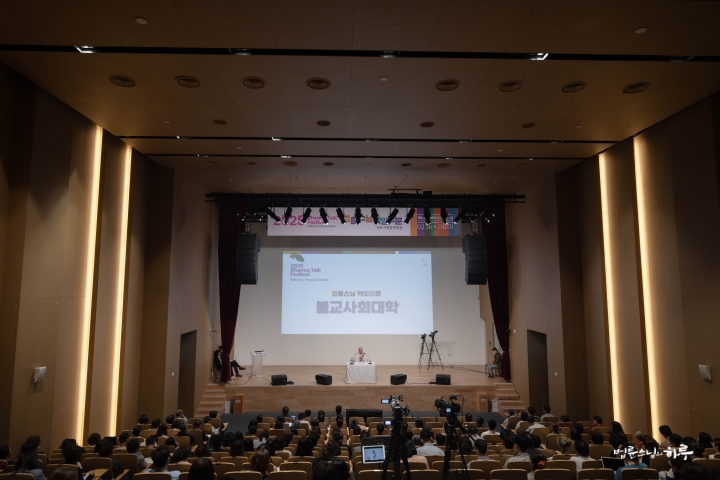
“Today, we’re going to talk about ‘peace.’ There are two main approaches to maintaining peace. One is peace through strength, based on the view that peace can be maintained when we have sufficient power. The other is the opposite concept, which is maintaining peace through dialogue and compromise.
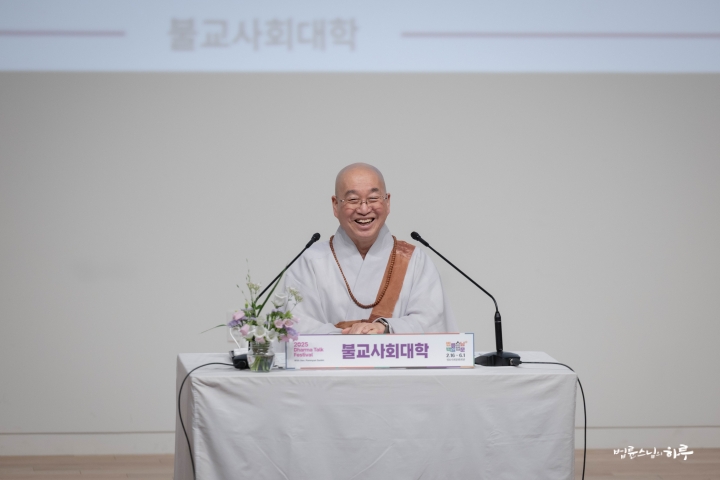
Can Power Maintain Peace?
Peace through strength is based on the idea that if our military power overwhelmingly surpasses that of our opponent, they wouldn’t dare to attack us. Today, many people accept this as a practical solution. However, when we build overwhelming power, our opponent feels threatened and tries to build even greater power. Then we must build up our power again to counter them. As we compete for superiority in this way, the arms race intensifies and eventually may lead to war and mass destruction.
After World War II, the United States and the Soviet Union engaged in an arms race. They competed in developing missiles and nuclear weapons, which eventually became an economic burden for both countries. Later, they held disarmament talks to reduce nuclear weapons to agreed-upon levels through compromise. This was because they had produced far more weapons than could ever be used in an actual war. What we can learn from this example is that peace doesn’t necessarily require building more and more military power. Having overwhelming strength doesn’t guarantee victory in war either. As seen in the Sui Dynasty’s invasion of Goguryeo or the Japanese Invasion of Korea in 1592, military superiority doesn’t guarantee victory in war.
The Buddha’s Approach to Realizing Peace
How did the Buddha realize peace? The Buddha mainly used “dialogue” to persuade others and stop wars. One day, when the Kingdom of Magadha was about to invade the Vajji clan, the king of Magadha sent a messenger to seek the Buddha’s advice. The Buddha taught seven methods to prevent the nation from perishing, and thanks to this teaching, the war was ultimately averted.
However, the Buddha couldn’t prevent all wars. When the Kingdom of Kosala was about to invade the Shakya clan, he was unfortunately unable to stop the war. At that time, the Buddha was sitting quietly under the scorching sun along the path where the army was passing. The general of Kosala dismounted from his horse, paid his respects, and asked, “Why are you sitting in the hot sun? There’s cool shade under the mango tree over there.” The Buddha replied, “No matter how good any shade in this world might be, none is better than the shade of one’s own clan.” Moved by these words, the general led his army away. But upon reflection, his anger resurfaced. He had a grudge against the Shakya clan for their previous mistreatment. So he returned with his army to attack, and again found the Buddha sitting quietly along the path. The same conversation took place, and again he withdrew. However, his mind had changed by the next time. He resolved, “Tomorrow, even if the Buddha blocks the way, I will have to march over him,” and returned with his army.
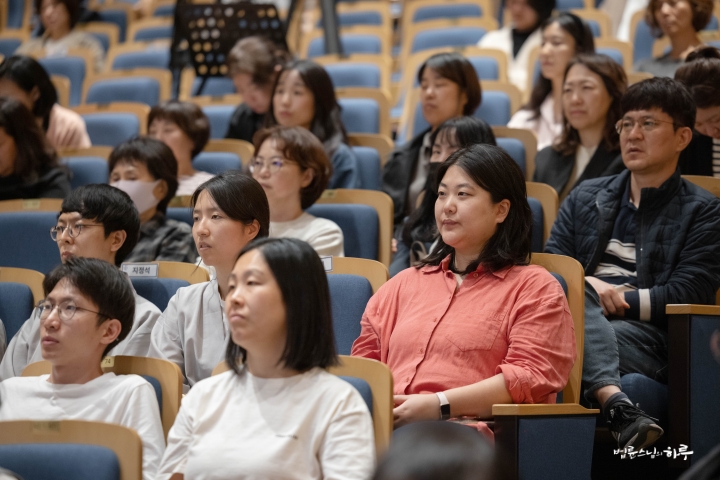
At that time, the Buddha no longer went to intercept them. When he had exhausted all possible methods, the Buddha quietly withdrew. He neither stood in the way prepared for martyrdom, nor did he mobilize his disciples to block them by force. Eventually, when the Kingdom of Kosala destroyed the Shakya clan, the Buddha’s persuasion failed to prevent the war. The Buddha tried his best to prevent the war through persuasion, but when it no longer worked, he stepped back, recognizing it as a worldly matter.
Peace Begins When We Accept Our Differences
The most important principle for maintaining peace is acknowledging our differences. This principle applies not only to major conflicts like disputes or wars but also to all conflicts in our daily lives. We must recognize that others are different from us. We need to acknowledge that we have different thoughts, ideologies, interests, and perspectives. This recognition of our differences is what we call “respect.” Here, “respect” doesn’t mean to revere the other person. It means to recognize the other as an equal being, just like yourself.
Going a step beyond respect is “understanding.” Understanding is the mindset of considering things from the other person’s perspective. The attitude of accepting that “it could be that way” is understanding. It means thinking from a child’s perspective, an adult’s perspective, North Korea’s perspective, South Korea’s perspective, a Japanese person’s perspective, an American’s perspective, the ruling party’s perspective, or the opposition party’s perspective. Understanding can also be called “love” in other words. Love without understanding is violence. Many people consider their affection for someone as love, but in reality, it is more likely to be desire. True love is based on understanding. Love that stems from understanding has no hatred. However, what we commonly call love can easily turn into hatred if things don’t go our way.
To move toward peace, we need to gather frequently and discuss. Even if our thoughts and perspectives differ, we should seek consensus through dialogue rather than trying to overpower each other by force. That’s why the Sangha has established the Karma system. The Karma system is a method where the community gathers to discuss any issue and reaches a conclusion that everyone can accept. This culture of consensus plays a crucial role in maintaining peace.
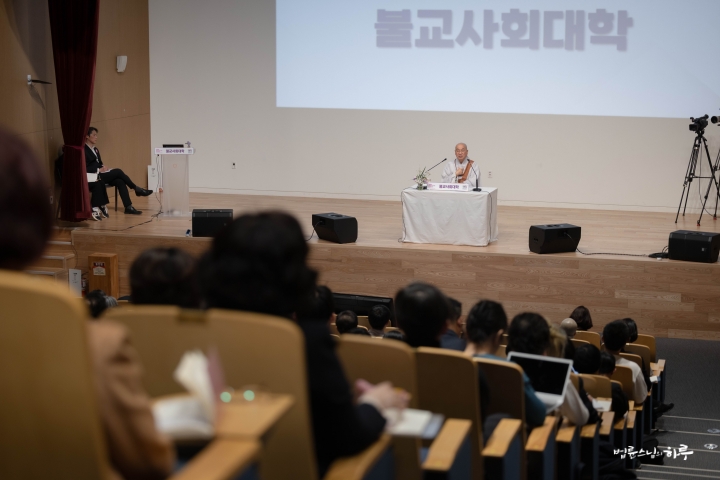
There is no such thing as a just war, a good war, or a righteous war. War is always horrific and leads to miserable consequences. War itself is a tragedy and a crime. Nevertheless, the previous Yoon Suk-yeol administration pursued peace through strength. In South Korea, there was talk of “erasing Pyongyang from the map,” while North Korea threatened to “turn Seoul into a sea of fire.” Recently, many have argued that “we should unify by force” since South Korea has the upper hand in national power and defense capabilities. It might seem like unification through military force could be achieved in a short period, but remember the Korean War. War never unfolds as expected. The consequences always bring unimaginable damage.
War Resolves Nothing
If war breaks out in our country again, winning or losing is not the issue. More fundamental than whether unification happens is the fact that our industrial achievements built over half a century could collapse in an instant. If martial law is declared, democracy could also be at risk of collapse. Even if unification were achieved this way, there would be nothing to gain. The losses from war would be far greater. Yet some foolish people still advocate for war. Citizens, too, become emotionally charged and easily support the logic of peace through strength. “If North Korea fires one shot, we should retaliate!” “We should develop nuclear weapons too!” Such arguments emerge everywhere. North Korea is a country that developed nuclear weapons while its people starved. How many people would sincerely agree with the argument that South Korea should develop nuclear weapons at the expense of its economy? If we could maintain our current economic level while possessing nuclear weapons, many would probably support it. However, according to the Nuclear Non-Proliferation Treaty (NPT), nuclear weapons development is internationally prohibited. To develop nuclear weapons, we would have to endure economic sanctions and, above all, build them in secret. No country has ever developed nuclear weapons while publicly advocating for them as we are doing now. It is a dangerous and lonely path.
Yet, when conducting opinion polls, they simply ask, “Do you support or oppose nuclear weapons possession?” without mentioning these realities. Naturally, people tend to agree that we should have nuclear weapons since North Korea has them. Such opinion polls are ultimately meaningless. A meaningful poll would ask, “Do you think we should possess nuclear weapons even if it means economic collapse and international isolation like North Korea?” If the majority still answered, “We should have nuclear weapons anyway,” that would represent genuine public opinion. However, it’s highly likely that only a minority would agree with this.
The year 2017 saw the highest risk of war on the Korean Peninsula since the Korean War. After Trump was elected as the U.S. President that year, inter-Korean and U.S.-North Korean relations deteriorated to the brink of war. That’s why Jungto Society held an anti-war rally at Gwanghwamun. The situation was so urgent that 15,000 people gathered to protest against war. Then, as inter-Korean relations rapidly improved, the risk of war decreased for a while. However, since the Yoon Suk-yeol administration took office, the crisis of war has gradually intensified again, reaching its peak last year. Although not as extreme as in 2017, looking back, the risk of war was quite high, with attempts that could have triggered a limited war with North Korea. Now, that tension has somewhat eased. With Trump’s re-election in the United States and President Yoon Suk-yeol being impeached after wrongfully declaring martial law, tensions have subsided slightly. But this doesn’t mean all problems have been resolved. The question of how we will create peace in this situation remains.
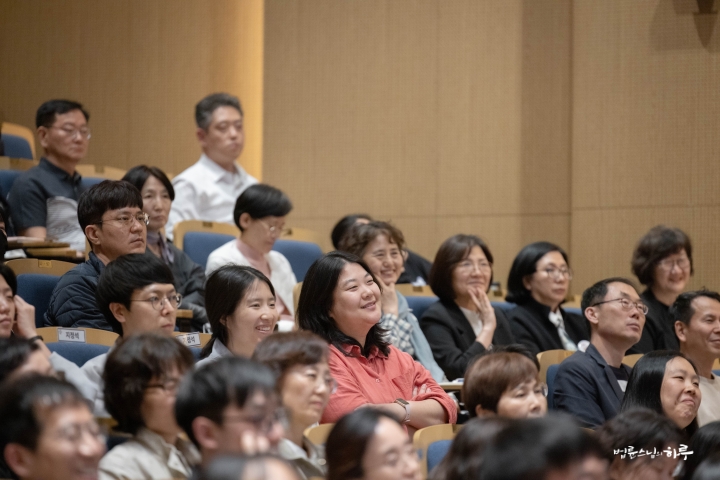
Why We Must Dialogue Even with Enemies
There are three types of dialogue or negotiation we engage in with others. The first is dialogue that takes place in completely adversarial relationships, between enemies. Even in such situations, dialogue is necessary. Even if Ukraine and Russia attempt dialogue now, it would occur not in a friendly relationship but in a hostile one. The same applies to inter-Korean dialogue. Dialogue in adversarial relationships is inherently difficult. Because of mutual hostility, people often ask, “How can we sit at the negotiation table with our enemy?” Nevertheless, dialogue becomes even more necessary in hostile situations. This is because an adversarial relationship is a state where both sides are incurring losses. Continuing on this path leads to greater damage. To prevent the enormous losses of war, dialogue must take place even in hostile situations.
If war is already underway, dialogue for a ceasefire is needed to prevent further damage. Most people are reluctant to engage in dialogue with adversaries. However, dialogue in adversarial relationships can actually bring the greatest benefits because reducing losses ultimately creates greater gains for us. Therefore, even in adversarial relationships, dialogue must occur to minimize losses. This is precisely why dialogue between North and South Korea is necessary.
The second type is dialogue in mutually friendly relationships. The reason we establish diplomatic relations with countries like Syria and Cuba is to create mutually friendly relationships through dialogue. This is about becoming friends for mutual benefit.
The third type is dialogue in allied relationships. Currently, South Korea and the United States are sitting at the negotiation table, arguing over tariff agreements. This is dialogue taking place in an already good, allied relationship. Dialogue in allied relationships sometimes requires accepting certain losses. You can’t abandon a friend just because you suffer some disadvantage. Friends don’t always provide benefits, and enemies don’t always cause losses. We must dialogue with enemies to reduce losses, and we must maintain relationships with friends through dialogue even if it means accepting some losses. Therefore, because the current South Korea-US relationship is a friendship, dialogue must continue even if there are some disadvantages.
With other countries, we should dialogue for mutual benefit. In contrast, although our relationship with North Korea is hostile, dialogue is absolutely necessary to reduce losses. Yet many of you, swayed by emotions, say, “How can we dialogue with an enemy!” In the National Assembly, statements like “How can we sit at the same table with those who support insurrection!” are made. However, even if they were actual insurrectionists rather than merely supporters, we must engage in dialogue if it stabilizes national discourse and benefits the people. We must dialogue even with enemies we are at war with.

There are various types of dialogue. Understanding this is essential for anyone to be able to communicate with others. You shouldn’t think, ‘How can I talk to such a bad person?’ While I might see the other person as bad, they might view me the same way. Therefore, to minimize losses, we must attempt dialogue. If conflict were to break out between North and South Korea, who would suffer greater losses? Although South Korea is ahead in many aspects, what would happen if war broke out and key facilities like Samsung Electronics, Hyundai Motors, or nuclear power plants were destroyed or bombed? The losses we would face in a war are immeasurable. Yet some people make foolish judgments about going to war without understanding this reality.
In a war, South Korea, with its developed economy, would inevitably suffer far greater damage. That’s why war must be avoided at all costs. Yet some people say, ‘What did we do wrong that we should act submissively toward North Korea?’ or ‘Why are you taking North Korea’s side?’ Ironically, these same people would likely be the first to flee abroad if war broke out. The idea of achieving unification through war is truly dangerous.
If we can’t eliminate North Korea’s nuclear weapons, is leaving them alone the answer?
If North Korea currently possesses 10 nuclear weapons, leaving the situation unaddressed could lead to an increase to 50 or even 100 weapons. What realistic options do we have in this situation? Is it better to keep the number fixed at 10, or allow it to increase to 50 or 100? Of course, having no nuclear weapons would be ideal. However, that’s just an ideal—realistically, there’s no way to achieve it. Eliminating North Korea’s nuclear weapons would require bombing, which would trigger a larger war. Yet if we do nothing, North Korea’s nuclear arsenal will continue to grow. Thinking rationally, our best option is to guide the situation to stop at the current state. When I suggest this, people object, saying, ‘Are you suggesting we accept North Korea’s possession of nuclear weapons?’ Nevertheless, realistically, our only choice is to make them stop at this point.
Comparing the demands of the US and North Korea, the US insists, ‘Eliminate nuclear weapons,’ while North Korea demands, ‘Lift economic sanctions.’ But what if the US lifts sanctions first, and North Korea still doesn’t dismantle its nuclear program? Even if sanctions were reimposed, they would only be effective with cooperation from China and Russia. Conversely, if North Korea dismantles its nuclear program and the US doesn’t fulfill its promise to lift sanctions or establish diplomatic relations, that too would end in failure. These issues arise because neither side trusts the other.
So what is the realistic path to peace? We should ask North Korea for a nuclear freeze rather than complete dismantlement. Similarly, we should propose a temporary lifting of economic sanctions rather than a permanent removal. Once economic sanctions are completely lifted, it’s difficult to reinstate them, but temporary measures can be reversed as needed. This is how dialogue must begin. While publicly advocating for unconditional talks, negotiations for a nuclear freeze and temporary lifting of economic sanctions should proceed behind the scenes.
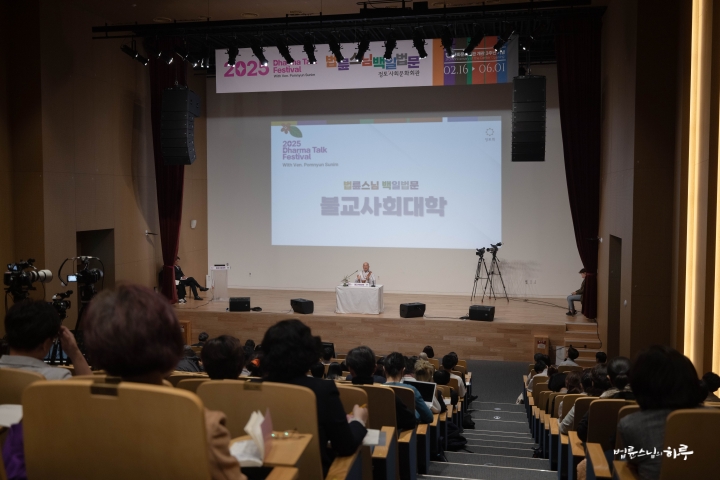
The normalization of North Korea-US relations, which is currently set as the final stage of negotiations, might be nothing more than a single sheet of paper. So instead of fixating on it too much, let’s consider moving it from the final stage to the starting point of negotiations. While it may appear on the surface as “dialogue for normalizing North Korea-US relations,” in reality, it would be about building trust and expanding relations based on “nuclear freeze and temporary lifting of economic sanctions.” I believe this is the only way to expect progress in negotiations under the current circumstances.
Of course, those who oppose this view strongly object, asking, “Are you suggesting we recognize North Korea’s nuclear weapons?” However, if we only oppose without offering alternatives, we can only maintain the status quo. In that case, North Korea will not stop developing nuclear weapons, and North Korean citizens will continue to suffer economic hardship. Is a policy that perpetuates civilian suffering while increasing dangers truly desirable? The direction we should move toward is reducing risks while substantially improving the lives of North Korean people. To achieve this, we must create a peace system on the Korean Peninsula through the normalization of North Korea-US relations and, furthermore, North Korea-Japan relations.”
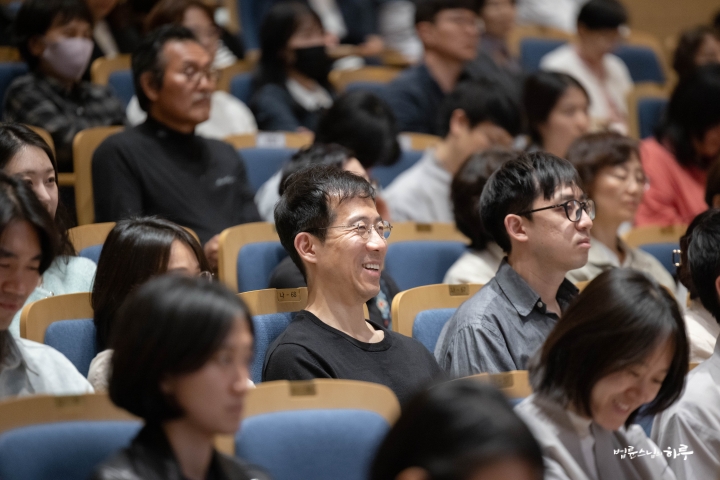
The next session will focus on “Buddhism’s Social Engagement” as the lecture topic, and the class concluded after 9 PM.
The participants engaged in mindful sharing in their respective groups, while Sunim returned to the Peace Foundation reception room to meet with Ms. Yoon Sinae from Washington D.C. and catch up after a long time. Ms. Yoon has been volunteering at the US Jungto Society Center for many years. After exchanging greetings, Sunim returned to the Jungto Center and concluded the day’s activities.
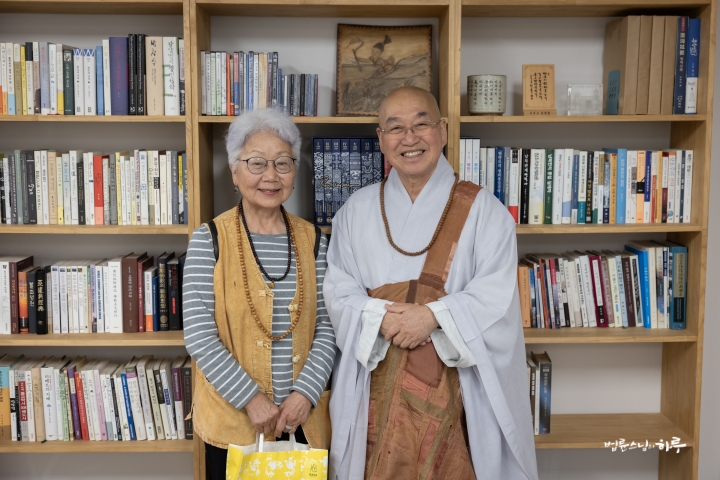
Tomorrow will be the 86th day of the 100-Day Dharma Talk. In the morning, Sunim will teach the second lecture on “Human Buddha” for the daytime Jungto Buddhism Course, meet with foreign policy and security experts in the afternoon, and then teach the same “Human Buddha” lecture for the evening Jungto Buddhism Course.





